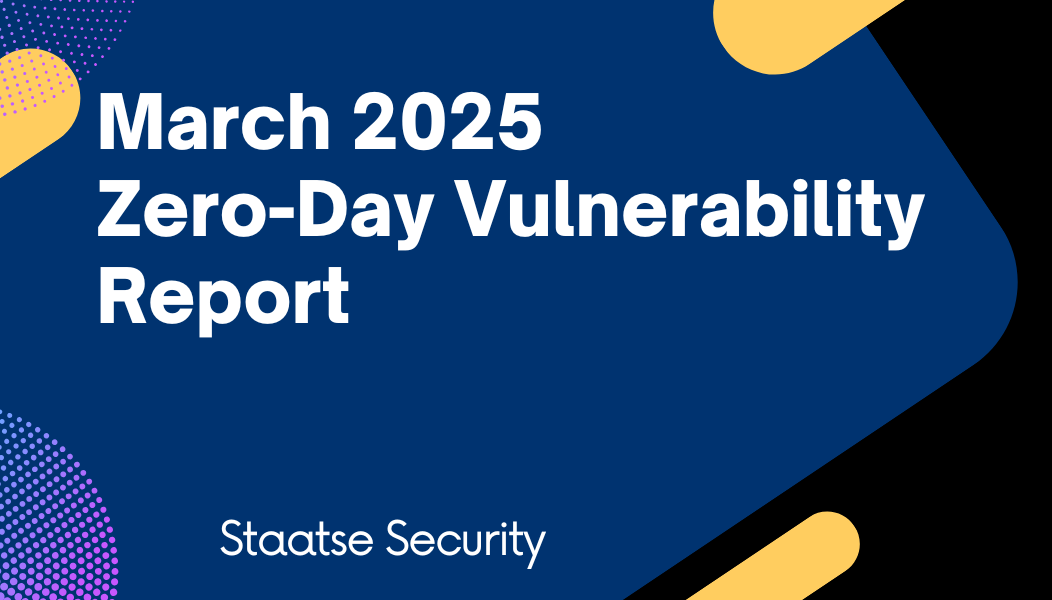
by staatse | Apr 11, 2025 | API Security, Application Security, Cloud Security, CMS Security, Cybersecurity, IT Security Services, Network Security, Penetration Testing, Security Best Practices, Uncategorized, Vulnerability Management
Introduction:
In March 2025, several critical zero-day vulnerabilities were identified and addressed by major software vendors, including Microsoft and Adobe. This report highlights the key vulnerabilities, their potential impacts, industry-specific insights, and practical advice for small businesses.
Microsoft Patches:
Microsoft released patches for 56 new CVEs, including six critical vulnerabilities and 50 important ones. Notably, six zero-day vulnerabilities were actively exploited in the wild. Key vulnerabilities include:
-
CVE-2025-26633: A security feature bypass in Microsoft Management Console, actively exploited.
-
CVE-2025-24985: A remote code execution vulnerability in the Windows Fast FAT File System Driver.
Adobe Patches:
Adobe addressed 37 CVEs across multiple products, including Acrobat Reader, Illustrator, and InDesign. Critical vulnerabilities in these products could allow attackers to execute arbitrary code.
Industry-Specific Data:
-
Finance: Financial institutions are particularly vulnerable to zero-day exploits due to the sensitive nature of their data. The CVE-2025-26633 vulnerability could allow attackers to bypass security features and gain unauthorized access to financial systems.
-
Healthcare: The healthcare sector, with its reliance on electronic health records, is at risk from vulnerabilities like CVE-2025-24985, which could lead to data breaches and compromise patient information.
-
Manufacturing: Manufacturing industries using Windows-based systems for automation and control could be affected by remote code execution vulnerabilities, potentially disrupting operations.
Implications of These Vulnerabilities:
Zero-day vulnerabilities pose significant risks as they are exploited before patches are available. The implications include:
-
Data Breaches: Unauthorized access to sensitive data.
-
Operational Disruption: Interruption of business operations and services.
-
Financial Loss: Costs associated with data breaches, including fines and remediation efforts.
-
Reputation Damage: Loss of customer trust and brand reputation.
Common Vulnerabilities for Small Businesses:
-
Misconfigurations: Incorrect settings in applications, databases, or network devices can create weak points that hackers can exploit.
-
Unpatched Software: Outdated software versions with known vulnerabilities can be targeted by attackers.
-
Weak Credentials: Using easily guessable passwords or reusing passwords across different systems increases the risk of unauthorized access.
-
Lack of Data Encryption: Storing sensitive data without encryption makes it easier for attackers to access and misuse it.
-
Unsecured APIs: APIs that are not properly secured can be exploited to gain unauthorized access to systems and data.
-
Zero-Day Vulnerabilities: These are vulnerabilities that are exploited before a patch is available, posing significant risks.
How Small Businesses Can Improve Security:
-
Conduct Regular Security Assessments: Evaluate your current cybersecurity posture to identify and address vulnerabilities.
-
Implement Strong Access Controls: Use role-based access control (RBAC) to limit access to sensitive information based on job roles. Enforce multi-factor authentication (MFA) to add an extra layer of security.
-
Train Employees: Educate your staff on cybersecurity best practices, such as recognizing phishing emails, using strong passwords, and avoiding suspicious downloads.
-
Secure Your Networks: Encrypt your internet connection and use firewalls to protect your network. Ensure your Wi-Fi network is secure and hidden.
-
Keep Software Updated: Regularly update all software, including operating systems, web browsers, and applications. Enable automatic updates to ensure timely patching.
-
Encrypt Sensitive Data: Use encryption to protect sensitive data both in transit and at rest.
-
Backup Data Regularly: Maintain regular backups of critical data to ensure you can recover quickly in case of a cyberattack.
-
Limit Privileged Access: Restrict administrative privileges to essential personnel only. Regularly review and update access controls.
-
Invest in Cybersecurity Tools: Use antivirus software, intrusion detection systems, and other cybersecurity tools to monitor and protect your systems.
-
Develop an Incident Response Plan: Have a plan in place to respond quickly to security breaches. This should include steps for containment, eradication, and recovery.
Latest Trends in Cybersecurity:
-
AI-Powered Cybersecurity: Both attackers and defenders are leveraging AI for more sophisticated attacks and defenses.
-
Increased Focus on Zero Trust Security: Organizations are adopting zero trust models to enhance security.
-
Rise of Ransomware-as-a-Service (RaaS): Ransomware attacks are becoming more accessible to less skilled attackers.
-
Supply Chain Attacks: Cybercriminals are targeting supply chains to exploit vulnerabilities in interconnected systems.
-
Cybersecurity Skills Shortage: There is a growing demand for skilled cybersecurity
By addressing these common vulnerabilities and implementing robust security measures, small businesses can significantly enhance their cybersecurity posture and protect against potential threats.
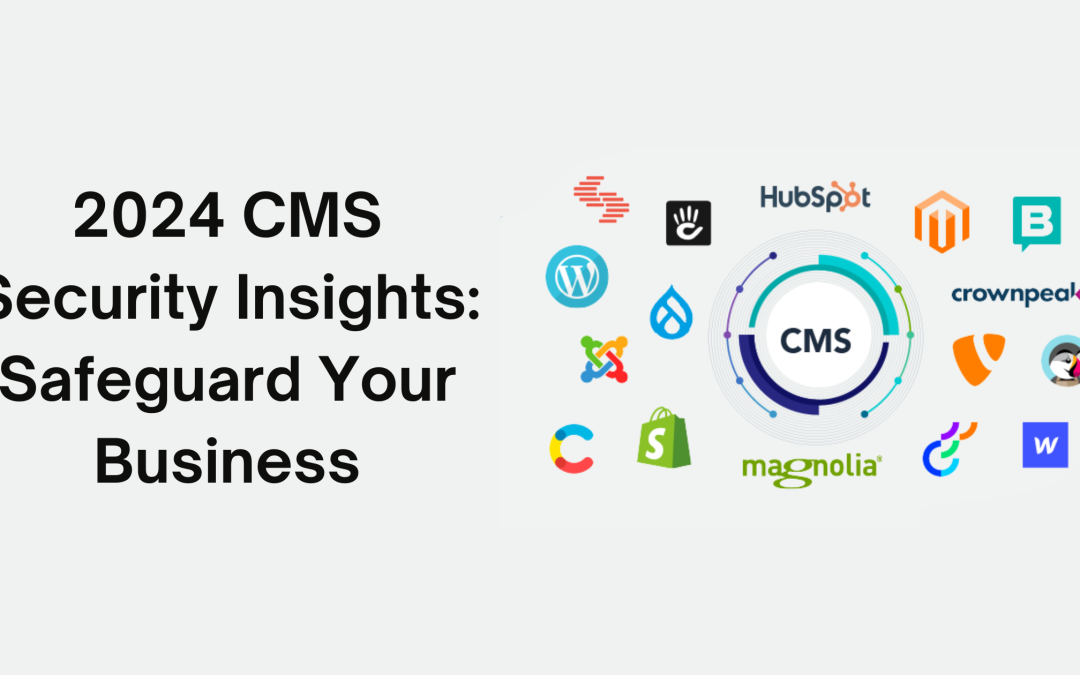
by staatse | Dec 26, 2024 | Application Security, CMS Security, Cybersecurity, IT Security Services, Penetration Testing, Security Best Practices
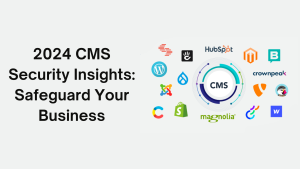
In today’s digital landscape, every industry—from retail and finance to healthcare and education—relies on Content Management Systems (CMS) to manage data, streamline operations, and interact with customers. However, as reliance on these systems grows, so do the risks. Cyberattacks targeting CMS platforms have become a significant concern, making CMS hardening and regular security assessments essential for all businesses.
Alarming Trends in CMS Compromises Across Industries in 2024
Recent reports show that cybercriminals are increasingly targeting CMS platforms across industries. A survey conducted by Cybersecurity Ventures revealed:
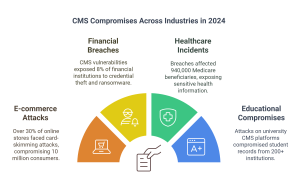
- E-commerce:
- Over 30% of online stores using CMS platforms like Magento and WooCommerce were hit by card-skimming attacks in 2024.
- These attacks compromised payment information of over 10 million consumers globally.
- Financial Services:
- CMS vulnerabilities in banking and investment platforms resulted in breaches exposing 8% of financial institutions to credential theft and ransomware demands.
- Healthcare:
- Incidents like the MOVEit breach affected 940,000 Medicare beneficiaries, exposing sensitive health information.
- Education:
- Attacks on university websites using CMS platforms such as Drupal led to the compromise of student records from 200+ institutions worldwide.
These numbers emphasize the widespread nature of CMS vulnerabilities, affecting every business domain.
What Is CMS Hardening?
CMS hardening is a preventive measure that enhances the security of CMS platforms to protect them against cyber threats. It involves:
- Access Controls:
- Implementing Multi-Factor Authentication (MFA) and strong password policies.
- Assigning user roles with the principle of least privilege.
- Regular Updates and Patch Management:
- Applying updates to address vulnerabilities in CMS software, themes, and plugins.
- Server and Network Security:
- Deploying firewalls, Secure Socket Layer (SSL) certificates, and intrusion detection systems (IDS).
- Backup and Disaster Recovery Plans:
- Regularly backing up data to ensure recovery in case of an attack.
Why Security Assessments Are Vital for Every Business
A robust security assessment identifies vulnerabilities and strengthens CMS defenses. Key processes include:
- Penetration Testing:
- Simulating cyberattacks to identify and patch vulnerabilities.
- Tailored to specific business risks, whether customer data theft for retail or ransomware for financial firms.
- Compliance Audits:
- Ensuring adherence to industry-specific regulations like PCI-DSS for retail, GDPR for global businesses, or HIPAA for healthcare.
- Continuous Monitoring:
- Deploying tools to scan for misconfigurations, outdated software, and suspicious activities.
The Cost of a Compromised CMS Across Industries
Failing to secure a CMS can have devastating consequences, including:
- Data Breaches:
- Retail: Theft of payment data damages customer trust.
- Education: Exposure of student records can lead to lawsuits.
- Financial: Leaked sensitive customer data impacts reputation and compliance.
- Operational Downtime:
- E-commerce websites face millions in lost revenue during extended downtimes caused by ransomware attacks.
- Reputational Damage:
- Customers and stakeholders lose trust in businesses unable to protect their systems.
How CMS Hardening and Security Assessments Secure Businesses
- Strengthened Defense:
- Proactively addressing vulnerabilities reduces the risk of being targeted.
- Improved detection and mitigation measures prepare businesses for modern cyber threats.
- Reduced Recovery Costs:
- Regular assessments identify potential issues before they escalate.
- Hardening decreases the likelihood of costly recovery efforts post-attack.
- Enhanced Customer Trust:
- Businesses known for robust security measures retain customer loyalty and maintain a competitive edge.
Actionable Steps for All Businesses
- Conduct a comprehensive security assessment of your CMS platforms every quarter.
- Regularly update and patch your CMS software and plugins.
- Harden CMS settings with strong access controls, firewalls, and encryption protocols.
- Implement continuous monitoring and AI-based threat detection tools to identify potential vulnerabilities in real time.
The Path Forward: A Safer Digital Business Environment
As 2024 unfolds, CMS hardening and security assessments are no longer optional—they are necessary. Whether you’re running a global e-commerce platform, a healthcare provider, or a university website, taking proactive security measures is critical to protect your business assets and ensure long-term growth.
Sources:
- Cybersecurity Ventures CMS Report
- Centers for Medicare & Medicaid Services Data Breach Update
- Verizon 2024 Data Breach Investigations Report
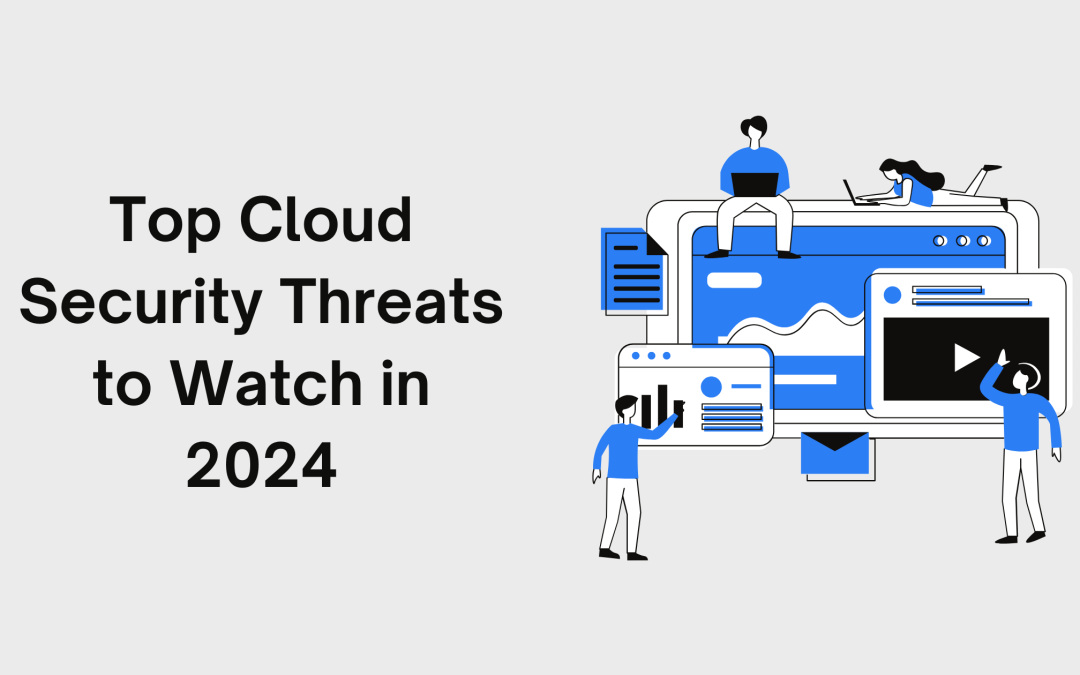
by staatse | Dec 24, 2024 | API Security, Application Security, Cloud Security, Cloud Solution, Cybersecurity, IT Security Services, IT Solution, Network Security, Penetration Testing
Cloud computing has become the backbone of modern businesses, with over 94% of enterprises using cloud services in some capacity. However, as the cloud continues to grow in adoption, so does the sophistication and frequency of threats targeting it. A recent survey revealed that 93% of organizations are moderately to extremely concerned about cloud security, making it a critical focus for 2024.
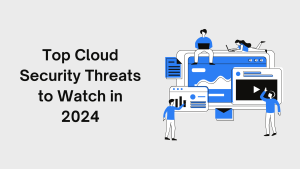
Why is Cloud Security Important?
Cloud environments host sensitive data, customer information, and business-critical applications. A breach could lead to:
- Data Loss or Theft: Exposing sensitive customer or company data.
- Financial Loss: Recovery costs, regulatory fines, and loss of customer trust.
- Downtime: Business operations disrupted, impacting productivity and revenue.
With the global cloud market expected to reach $832.1 billion by 2025, protecting these assets is paramount.
Top Cloud Security Threats in 2024
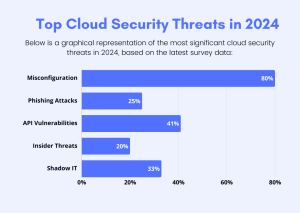
- Misconfiguration of Cloud Settings
According to industry reports, 80% of cloud security breaches are due to human error and misconfiguration. Examples include:
-
- Publicly exposed databases.
- Overly permissive access controls.
- Phishing Attacks Targeting Cloud Credentials
Phishing attacks continue to evolve, with cybercriminals now specifically targeting cloud-based email and collaboration tools. The Verizon 2023 Data Breach Investigations Report states that 25% of data breaches involved phishing.
- Inadequate Identity and Access Management (IAM)
Weak IAM policies can lead to unauthorized access to sensitive cloud resources. Over 50% of organizations admit to having at least one excessive privilege issue per week, according to Gartner.
- API Vulnerabilities
APIs are the backbone of cloud interactions but can also be an attack vector. 41% of organizations experienced API security incidents in 2023, as reported by Salt Security.
- Ransomware in the Cloud
Ransomware attacks are now targeting cloud environments through compromised backups or synced devices. Ransomware attacks increased by 13% in 2023, making it a persistent threat.
- Shadow IT
Unauthorized use of cloud services by employees bypassing IT policies creates vulnerabilities. 33% of security breaches are linked to shadow IT, according to McAfee.
- Insider Threats
Malicious or negligent employees pose significant risks. In 2023, insider threats accounted for 20% of cloud security incidents, based on a study by Ponemon Institute.
Emerging Trends in Cloud Security
- Zero Trust Architecture: More organizations are adopting zero trust principles to minimize the attack surface.
- Cloud-Native Security Tools: Use tools specifically designed for the cloud to enhance protection.
- AI-Powered Threat Detection: AI and machine learning are becoming crucial in identifying and mitigating threats in real-time.
Conclusion
Cloud security is not a one-time effort but an ongoing process. Organizations must stay vigilant, adopt best practices, and leverage advanced technologies to combat evolving threats. As we move into 2024, understanding and addressing these risks proactively will ensure that businesses can reap the benefits of the cloud without compromising on security.
Data Credits
Data and statistics cited in this article are sourced from the following:
- Verizon 2023 Data Breach Investigations Report
- Salt Security API Security Trends Report 2023
- McAfee Cloud Security Insights
- Ponemon Institute Insider Threats Report 2023
- Gartner IAM Practices and Insights 2023
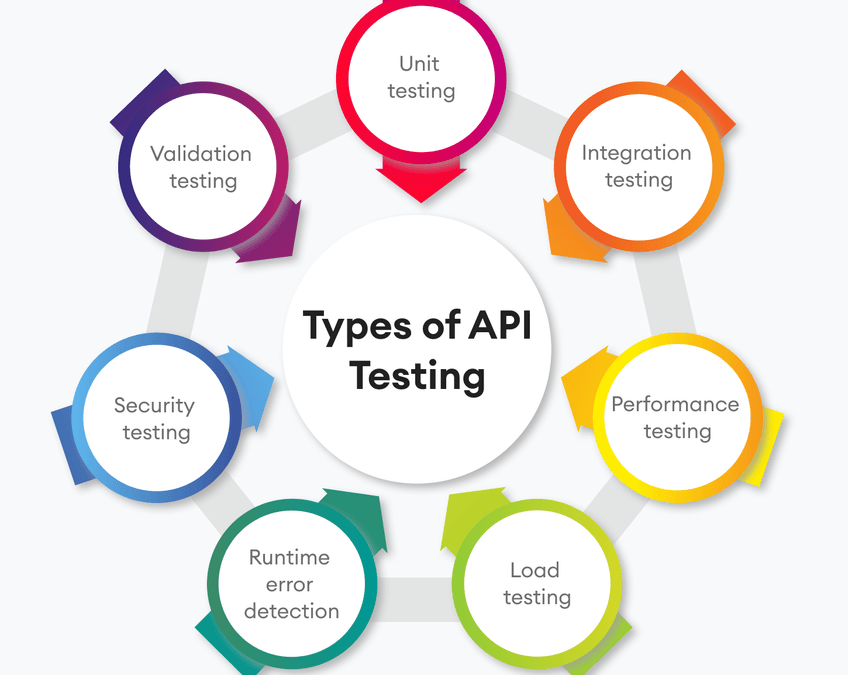
by staatse | Sep 27, 2024 | API Security, Application Security, Cybersecurity, IT Security Services, Penetration Testing
In Part 2 of “Mastering API Pentesting: Securing Your APIs from Vulnerabilities,” we dive deeper into the specific vulnerabilities that are common in APIs and explore the OWASP API Security Top 10 for both 2019 and 2023. This guide will help you understand the critical issues that pentesters target and provide insight into the evolving threat landscape.
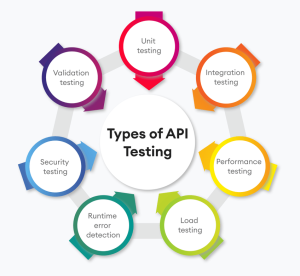
Top API Vulnerabilities:
- Broken Object Level Authorization (BOLA): When APIs expose object identifiers without proper access controls, unauthorized users can manipulate these objects, gaining access to sensitive data.
- Broken Function Level Authorization (BFLA): Occurs when users gain access to functions or endpoints they should not have permission to use, often by tampering with request parameters or methods.
- Security Misconfiguration: Insecure default configurations, outdated software, or overly permissive permissions lead to exploitable security gaps.
- Mass Assignment: Improper binding of client data, allowing unauthorized users to modify sensitive fields by guessing parameters or exploiting weak documentation.
- Code Injection: Malicious code is executed via SQL, NoSQL, LDAP, or OS command injection, which can manipulate the API’s backend processes.
- Broken User Authentication: Weak or improperly implemented authentication mechanisms can result in unauthorized access, session hijacking, or account takeover.
- Excessive Data Exposure: APIs may return more data than needed, potentially leaking sensitive information like PII or financial data.
- Insufficient Logging and Monitoring: Without proper logging and monitoring, suspicious activities can go undetected, leaving the system vulnerable to long-term exploitation.
What is OWASP?
The Open Web Application Security Project (OWASP) is a community-driven organization dedicated to improving software security. OWASP’s free tools, documentation, and resources help developers, organizations, and security professionals safeguard their applications and APIs.
One of the key contributions of OWASP is its API Security Top 10, which outlines the most critical API vulnerabilities, helping organizations stay informed about current security risks and mitigation strategies.
OWASP Top 10 API Vulnerabilities (2023)
- API1:2023 – Broken Object Level Authorization (BOLA): Remains the top vulnerability, emphasizing the importance of proper access control at the object level.
- API2:2023 – Broken Authentication: Expanded to cover issues like weak passwords, session management flaws, and insecure credential handling.
- API3:2023 – Broken Object Property Level Authorization: New vulnerability combining Excessive Data Exposure and Mass Assignment, focusing on unauthorized access to sensitive object properties.
- API4:2023 – Unrestricted Resource Consumption: Previously referred to as “Lack of Resources & Rate Limiting,” this vulnerability allows attackers to deplete system resources through uncontrolled API requests.
- API5:2023 – Broken Function Level Authorization (BFLA): Persistent in the top 5, highlighting the risks of poor authorization at the function level.
- API6:2023 – Unrestricted Access to Sensitive Business Flows: New entry focusing on unregulated access to critical business operations like transactions or reservations.
- API7:2023 – Server-Side Request Forgery (SSRF): Attackers exploit APIs to force internal requests to sensitive or internal systems, bypassing firewalls and security controls.
- API8:2023 – Security Misconfiguration: Continues to be a major issue due to insecure default setups and improper configuration practices.
- API9:2023 – Improper Inventory Management: Similar to 2019’s version, highlighting the risks associated with undocumented APIs and old endpoints.
- API10:2023 – Unsafe API Consumption: New in 2023, this issue focuses on APIs that rely on untrusted third-party APIs, making them vulnerable if the external APIs are compromised.
Conclusion
The API security landscape has evolved, but core vulnerabilities like BOLA and Broken Authentication continue to dominate. The 2023 OWASP list emphasizes the need for deeper control over resource consumption, sensitive business flows, and third-party API integration. Regular pentesting remains essential in identifying these vulnerabilities, and applying OWASP’s guidelines can significantly bolster an API’s defense.
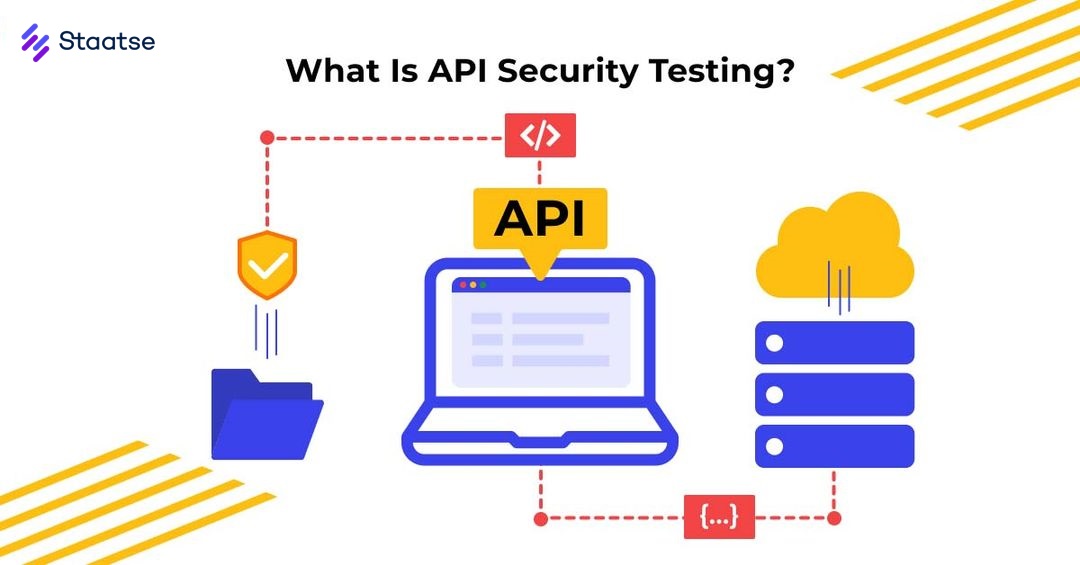
by staatse | Sep 27, 2024 | API Security, Application Security, Cybersecurity, IT Security Services, Penetration Testing
An API (Application Programming Interface) is essential for communication between different software systems. API pentesting is a process that identifies security vulnerabilities in these interfaces, helping prevent attackers from exploiting them. This guide provides an overview of API pentesting, common API types, and examples of various API architectures.
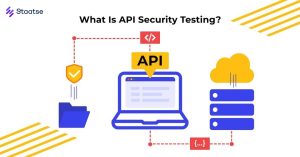
What is API Pentesting?
API pentesting involves testing APIs for security weaknesses such as:
- Injection attacks (e.g., SQL or XML injection)
- Sensitive data exposure
- Broken object-level authorization (BOLA)
- Broken function-level authorization (BFLA)
Pentesters simulate attacks to identify vulnerabilities, helping secure APIs before attackers can exploit them.
Importance of API Pentesting
- Identifying Security Vulnerabilities: APIs are common targets for security breaches. Pentesters identify potential vulnerabilities and recommend mitigation strategies.
- Protecting Sensitive Data: APIs handle sensitive data like passwords, personal information, and financial details. A breach can lead to data theft, financial losses, and damage to the organization’s reputation.
- Preventing Unauthorized Access: APIs often expose data to external users. Pentesting helps assess access control mechanisms to ensure only authorized users can interact with the API.
- Maintaining Business Continuity: Regular pentesting ensures APIs are secure, avoiding downtime or service interruptions caused by security incidents.
- Defense in Depth: API pentesting is part of a larger security strategy, adding multiple layers of defense against attacks.
Common API Types
APIs come in several forms, each with its security considerations:
- Public APIs: Open to external developers, but require proper authentication and authorization to prevent misuse.
- Partner APIs: Accessible only to authorized partners and require strong authentication and access control mechanisms.
- Private APIs: Used internally within organizations. While often protected by network-level security, they should still be pentested to ensure robustness.
- Composite APIs: Combine multiple services into one. They improve performance but may introduce security challenges that need thorough testing.
Popular API Architectures
1. RESTful API
RESTful APIs (Representational State Transfer) follow specific principles, focusing on statelessness, resource-based operations, and standardized HTTP methods (GET, POST, PUT, DELETE).
2. SOAP API
SOAP (Simple Object Access Protocol) is a messaging protocol that uses XML for exchanging structured information. It supports multiple transport protocols (HTTP, HTTPS, SMTP) and provides advanced security features like message encryption, digital signatures, and authentication.
Differences Between REST, SOAP, and GraphQL
- REST: Simple, stateless operations using HTTP methods (GET, POST, PUT, DELETE).
- SOAP: Strict and secure messaging protocol that uses XML and supports various transport protocols.
- GraphQL: Allows clients to request exactly the data they need, avoiding over-fetching and under-fetching issues.
Conclusion
API pentesting is essential for securing modern applications. Regular testing helps identify vulnerabilities, ensuring that sensitive data is protected, access controls are enforced, and the APIs are robust enough to withstand attacks. Stay tuned for Part 2, where we’ll dive into specific pentesting tools and techniques to secure APIs.
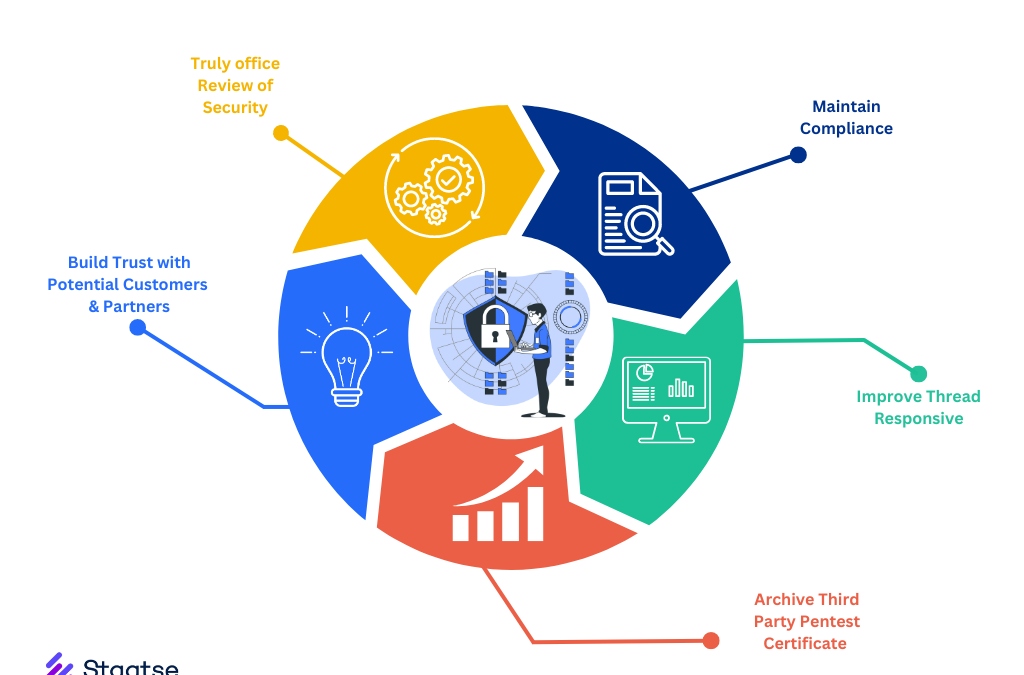
by staatse | Sep 19, 2024 | Application Security, Cybersecurity, Network Security, Penetration Testing, Vulnerability Management
In today’s digital landscape, businesses of all sizes depend heavily on technology to manage operations, store sensitive data, and engage with customers. This reliance, however, also increases the risk of cyber threats. To protect your business from potential attacks and data breaches, it’s crucial to implement strong security measures, and penetration testing is a key component of this defense strategy. But why is penetration testing so essential for your business? Let’s explore.
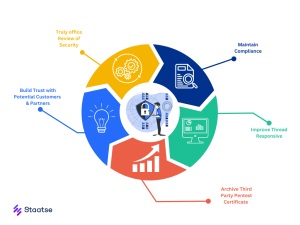
1. Identifying Vulnerabilities Before Attackers Do
- Proactive Detection: By simulating real-world attack scenarios, penetration testing can reveal vulnerabilities such as outdated software, weak passwords, or unsecured endpoints that cybercriminals could exploit.
- Comprehensive Assessment: It goes beyond traditional security measures, providing a thorough evaluation of your digital environment’s resilience against sophisticated attacks.
2. Enhancing Security Measures and Reducing Risk
Once vulnerabilities are identified, your business can take proactive steps to address these weaknesses. This not only strengthens your defenses but also reduces the risk of a successful cyberattack, protecting your sensitive data and maintaining business continuity.
- Tailored Security Improvements: Based on the findings, you can implement specific security measures such as applying patches, updating configurations, or enhancing monitoring practices.
- Risk Mitigation: Understanding the potential impact of each vulnerability allows you to prioritize and address the most critical issues first, reducing the overall risk to your organization.
3. Ensuring Compliance with Industry Regulations
Many industries are governed by strict regulatory standards, such as GDPR for data protection, HIPAA for healthcare, and PCI-DSS for payment card security. These regulations often require regular security assessments, including penetration testing, to ensure that sensitive information is adequately protected.
- Meeting Compliance Requirements: Regular penetration testing helps demonstrate your commitment to maintaining a high level of security and ensures that your business complies with industry-specific regulations.
- Avoiding Legal and Financial Penalties: Failing to comply with these regulations can result in significant fines and legal consequences. Penetration testing helps you avoid such risks by identifying and addressing potential compliance gaps.
4. Protecting Your Reputation and Building Trust
A data breach can have a devastating impact on your company’s reputation, leading to loss of customer trust, reduced revenue, and long-term damage to your brand. Penetration testing is a proactive measure that shows your commitment to cybersecurity, helping to build trust with customers, partners, and stakeholders.
- Customer Confidence: By proactively securing your systems, you reassure customers that their data is safe and that your business is a trustworthy partner.
- Brand Protection: Preventing breaches before they occur helps safeguard your brand’s reputation, avoiding the negative publicity and loss of trust associated with security incidents.
How to Implement Penetration Testing: A Step-by-Step Guide
1. Define Clear Objectives
Identify what you aim to achieve with penetration testing. Are you focusing on a specific application, network segment, or your entire IT infrastructure? Clearly defining your goals will help tailor the testing to your specific needs and ensure meaningful results.
2. Choose the Right Testing Approach
There are different methodologies to choose from:
- Black Box Testing: The tester has no prior knowledge of the system, simulating an external attack.
- White Box Testing: The tester has full access to the system’s architecture and source code, allowing for a comprehensive security evaluation.
- Gray Box Testing: The tester has partial knowledge of the system, representing a scenario where an insider or semi-privileged user might attack.
Select the approach that best aligns with your security objectives and budget.
3. Select a Reliable Penetration Testing Provider
Choose a reputable provider with experience in your industry. Look for a company that offers a structured approach, detailed reporting, and a clear plan for post-testing support. Ask for case studies or references to ensure they have a proven track record.
4. Conduct the Testing
During the testing phase, the penetration testing team will simulate attacks on your systems, identifying vulnerabilities and assessing their potential impact. They will then provide a comprehensive report detailing the findings, along with recommendations for remediation.
5. Address and Mitigate Vulnerabilities
The final step is to act on the findings from the penetration test. This might involve applying security patches, updating configurations, revising access controls, or implementing additional security measures. Regular follow-up testing can ensure that these vulnerabilities have been effectively addressed.
Conclusion
Penetration testing is a strategic investment that helps protect your business from the ever-evolving landscape of cyber threats. By proactively identifying and addressing security vulnerabilities, you not only enhance your defenses but also ensure compliance with industry regulations, protect your reputation, and build trust with your customers. In a digital world where security breaches are increasingly common, penetration testing is a crucial tool for maintaining a secure and resilient business environment.


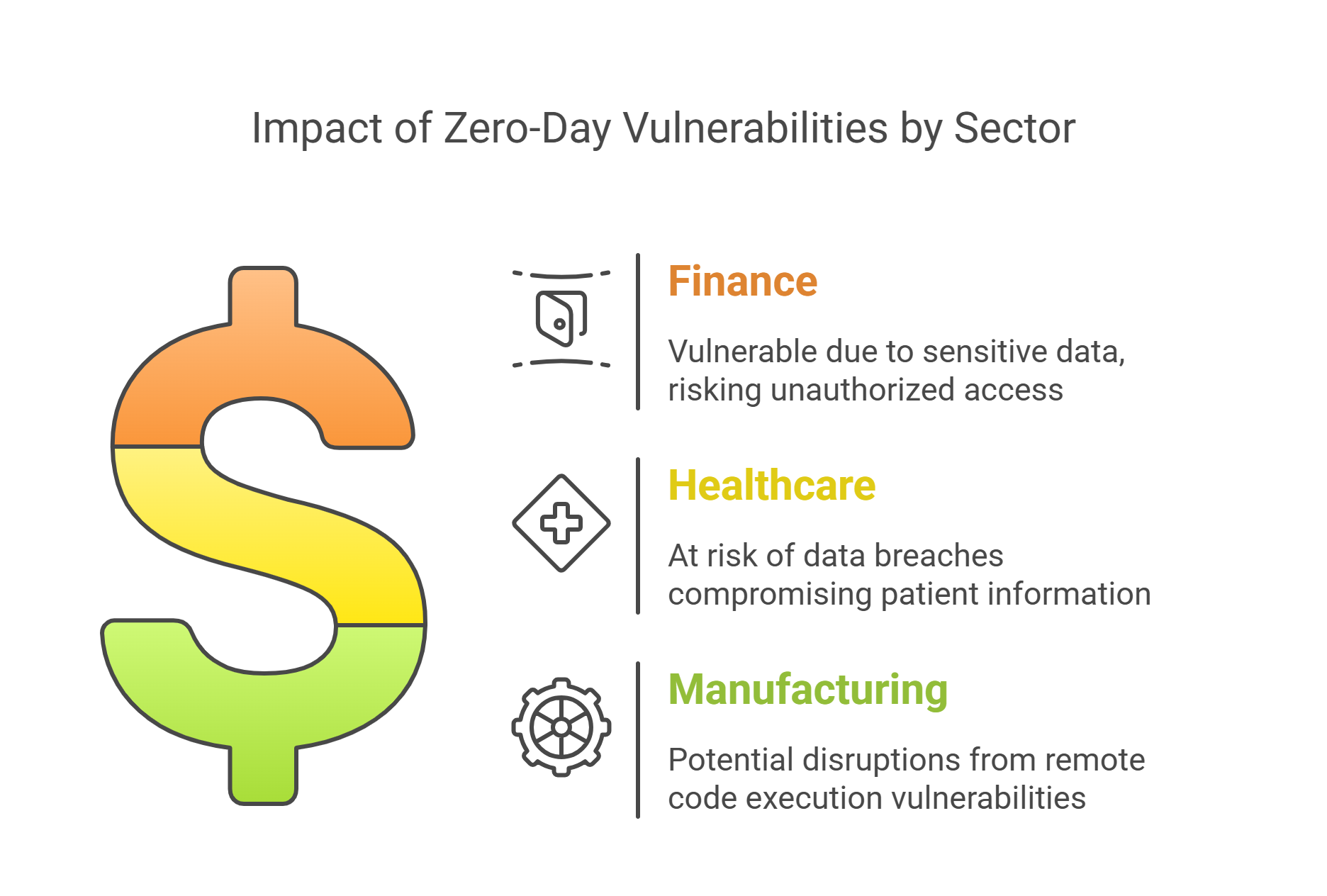
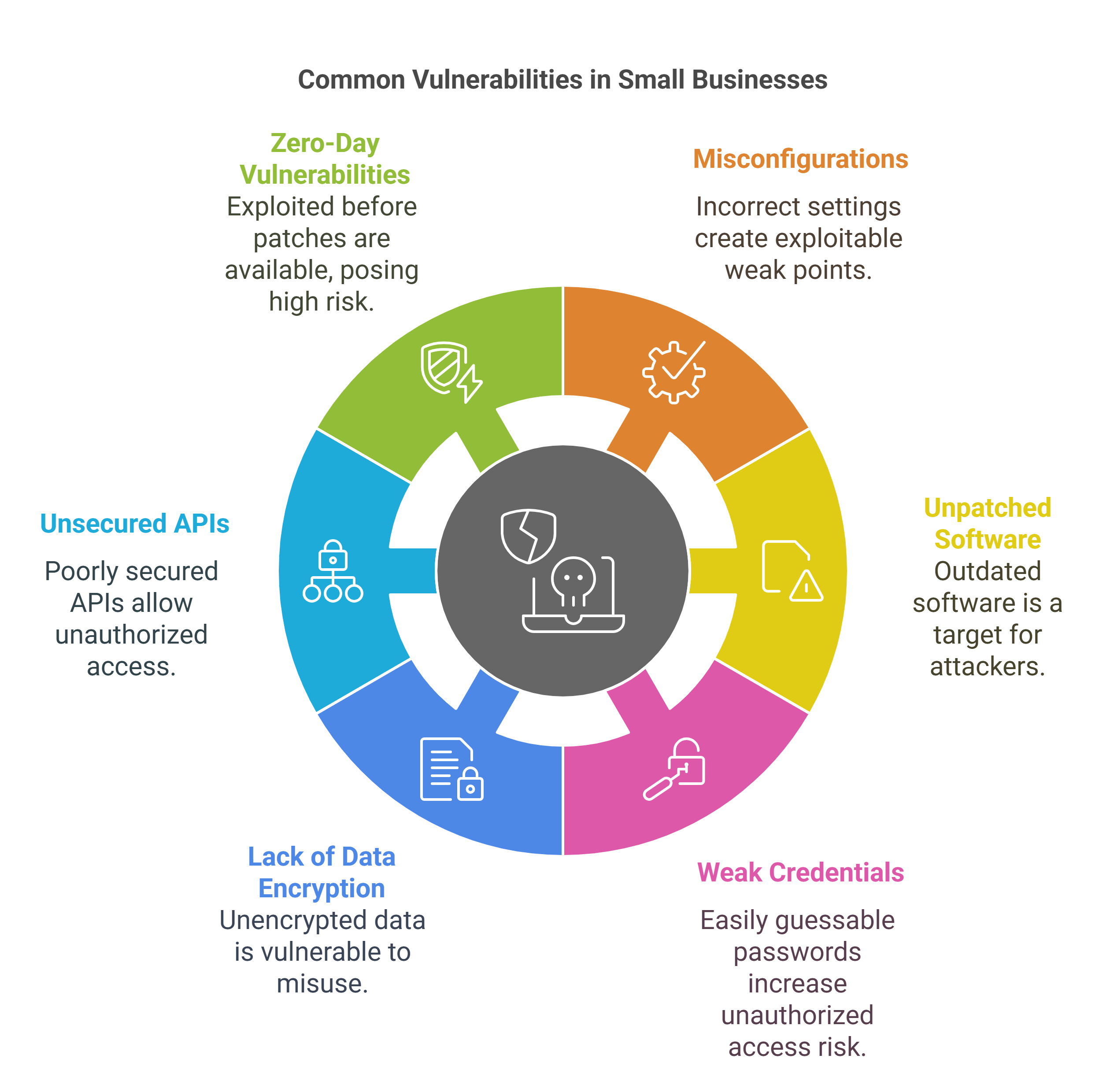
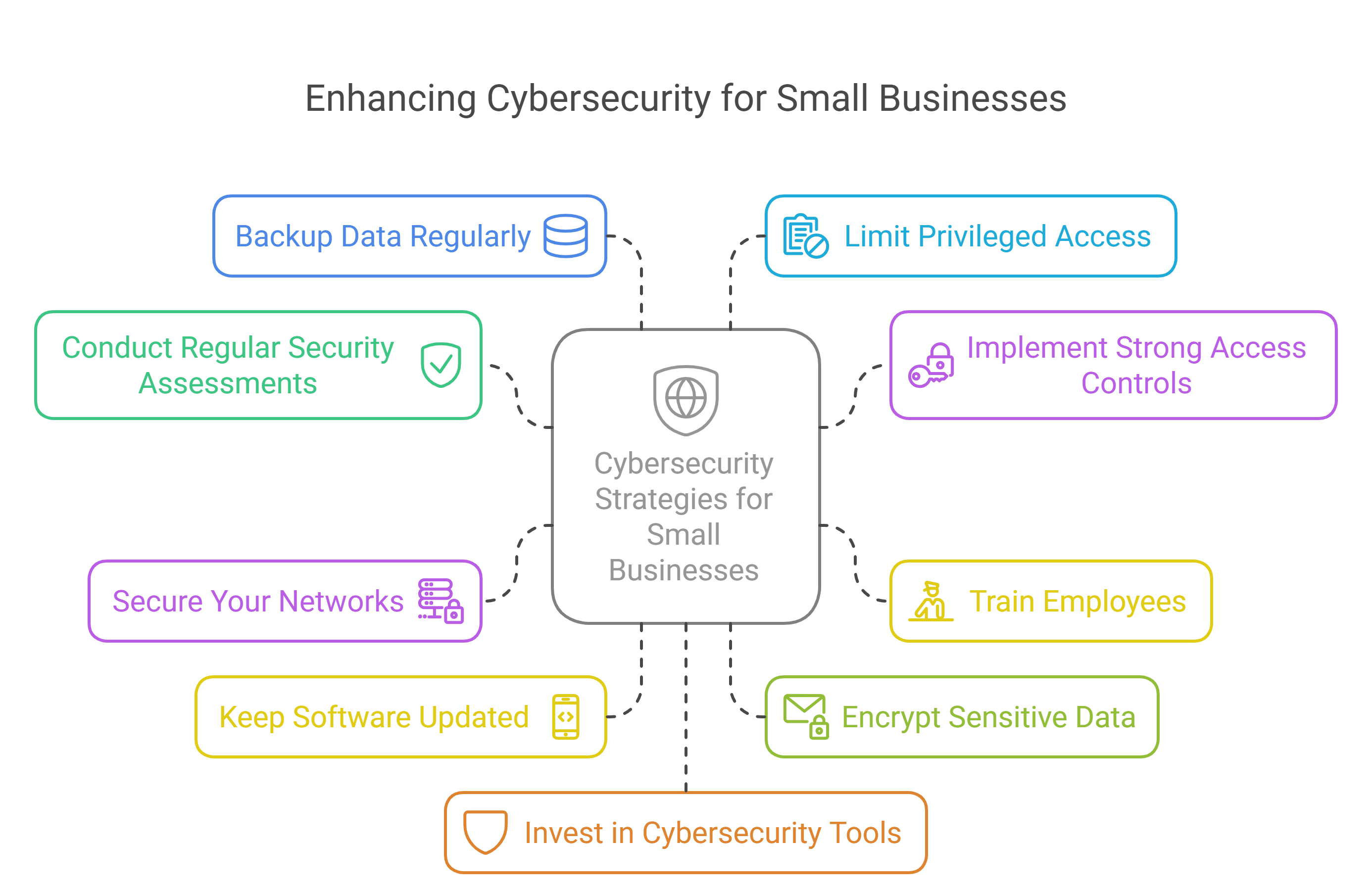
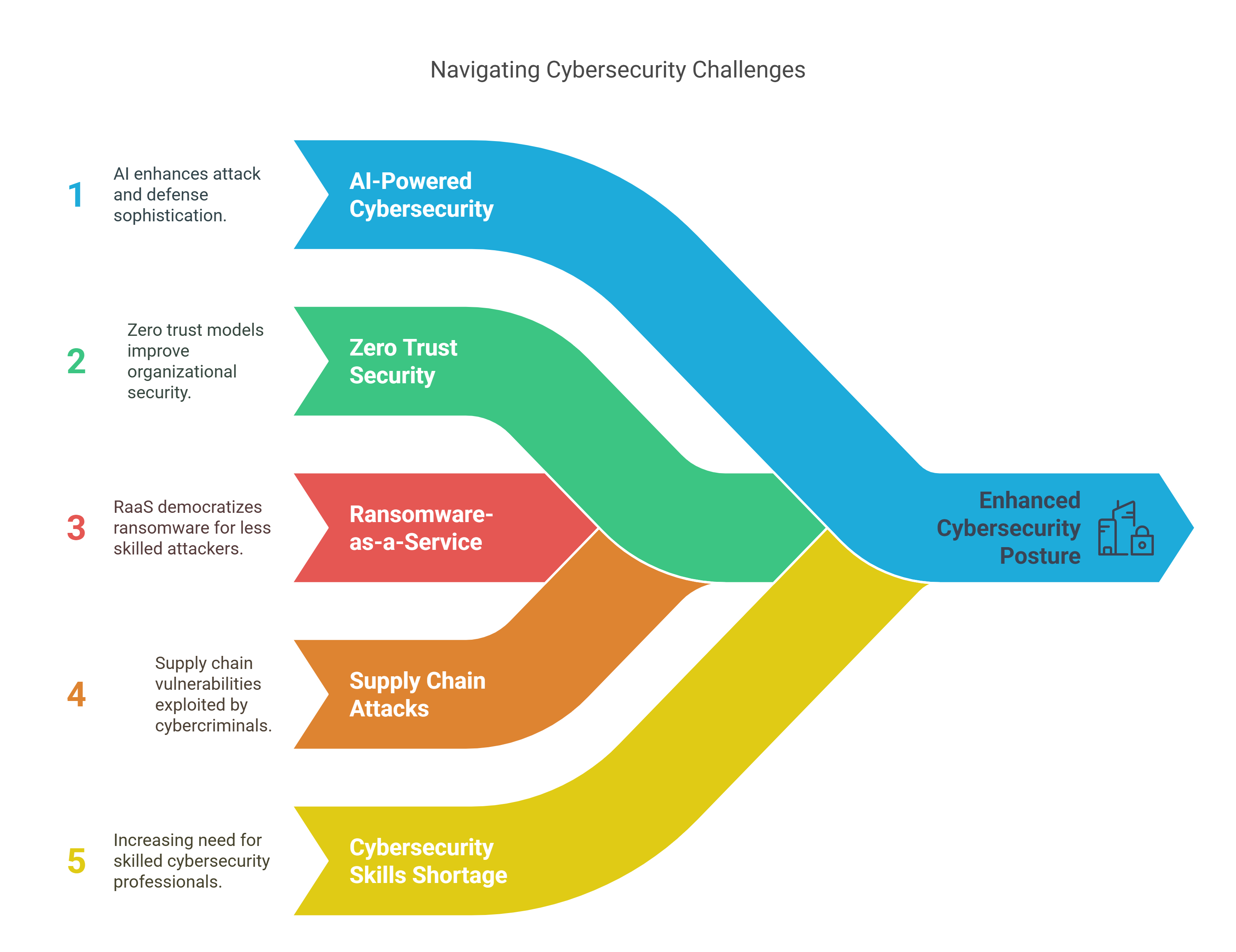

 In today’s digital landscape, every industry—from retail and finance to healthcare and education—relies on Content Management Systems (CMS) to manage data, streamline operations, and interact with customers. However, as reliance on these systems grows, so do the risks. Cyberattacks targeting CMS platforms have become a significant concern, making CMS hardening and regular security assessments essential for all businesses.
Alarming Trends in CMS Compromises Across Industries in 2024
Recent reports show that cybercriminals are increasingly targeting CMS platforms across industries. A survey conducted by Cybersecurity Ventures revealed:
In today’s digital landscape, every industry—from retail and finance to healthcare and education—relies on Content Management Systems (CMS) to manage data, streamline operations, and interact with customers. However, as reliance on these systems grows, so do the risks. Cyberattacks targeting CMS platforms have become a significant concern, making CMS hardening and regular security assessments essential for all businesses.
Alarming Trends in CMS Compromises Across Industries in 2024
Recent reports show that cybercriminals are increasingly targeting CMS platforms across industries. A survey conducted by Cybersecurity Ventures revealed:









